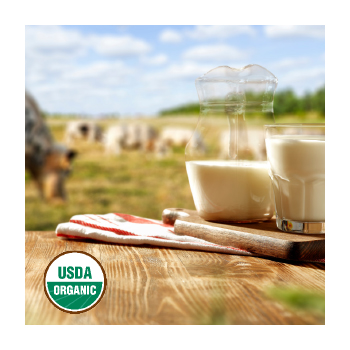


Sign-up for {N}power to get exclusive discounts, newsletters, members-only features, and more!

It’s a small seal carrying a big promise: USDA Certified Organic. Most of us recognize it as a label that pledges better—for human health, animal welfare, and the planet. Yet, some will suggest that’s all it is… promises. So, is there proof? Yes. And a 2019 study on milk is case-in-point.1 Scientists from Emory University tested organic and conventional milk samples, purchased from retailers across the United States, for commonly used antibiotics, pesticides, and bovine growth hormone (BGH) levels. The results were compelling in their disparities: up to 60 percent of conventional samples tested positive for antibiotic and pesticide residues, while the organic samples had none. Conventional milk also had significantly higher hormone levels.2
 Reach for a carton of milk, and you may see this claim on the label: “From cows not treated with rBST/rBGH.”3 4 5 These are the interchangeable abbreviations for recombinant bovine growth hormone, a genetically engineered product that Monsanto debuted in 1993 to increase milk production in dairy cows.6 7 However, two things are important to note for consumers deciphering milk labels. Because cows naturally produce bovine growth hormone, there will always be some measure of BGH in milk. Yet, there is no test to differentiate the genetically modified substance from the naturally occurring one, so it’s impossible to tell if synthetic hormones are in your dairy products, let alone how much. In the Emory study, BGH was 20 times higher in conventional milk than organic, a system that prohibits the use of artificial growth hormones.
Reach for a carton of milk, and you may see this claim on the label: “From cows not treated with rBST/rBGH.”3 4 5 These are the interchangeable abbreviations for recombinant bovine growth hormone, a genetically engineered product that Monsanto debuted in 1993 to increase milk production in dairy cows.6 7 However, two things are important to note for consumers deciphering milk labels. Because cows naturally produce bovine growth hormone, there will always be some measure of BGH in milk. Yet, there is no test to differentiate the genetically modified substance from the naturally occurring one, so it’s impossible to tell if synthetic hormones are in your dairy products, let alone how much. In the Emory study, BGH was 20 times higher in conventional milk than organic, a system that prohibits the use of artificial growth hormones.
Although the official stance of the FDA is that the presence of rBST in milk poses “no significant difference” for the consumer in terms of nutritional value or health, some studies beg to differ.8 The focus is on a protein called IGF-1 (insulin-like growth factor-1), produced in the liver in response to BGH, and its potential links, at high levels of exposure, to adverse outcomes, including on childhood growth and development and increased risk of some cancers. IGF-1 concentrations were three times higher in conventional milk samples than organic.9 10
There is a substantial cost to animal health associated with using rBST as well. A review commissioned by the Canadian Veterinary Medical Association concluded that the risk of clinical lameness in rBST treated cows was increased by roughly 50 percent. They also found links to reproductive issues and approximately a 25 percent greater frequency in clinical mastitis during the treatment period.11 A rise in mastitis necessitates increased antibiotic use as well.12
While multiple conventional milk samples tested positive for antibiotic residue, most were below the safety limits set by the FDA, with a few notable exceptions. Traces of two antibiotics banned in dairy production, sulfathiazole and sulfamethazine, showed up in 26 percent and 37 percent of conventional samples, respectively.13 Additionally, one sample tested above the FDA's permitted limits for amoxicillin, an antibiotic from a family of penicillin that are known allergens to as much as 10 percent of the population.14
When avoiding synthetic pesticide residues, fresh produce and grains are the focus of many consumers—not milk. Yet, in the Emory study, up to 60 percent of conventional milk samples tested positive for residues of pesticides, including atrazine and diazinon. The Pesticide Action Network describes atrazine as a "potent endocrine disruptor.”15 They also report that, like diazinon, studies have shown it may harm sperm counts.16
Organic standards prohibit hormones, antibiotics, GMOs, and synthetic pesticides in dairy production. They also require that cows graze on pasture for the entire grazing season, which must be a minimum of 120 days per year, and the animals must be outside year-round, weather permitting. This is beneficial for the animals and the planet. So, if you wish to be confident about what a label stands for and what isn’t in it, look for the small seal that keeps its big promises!



Sign-up for {N}power to get exclusive discounts, newsletters, members-only features, and more!